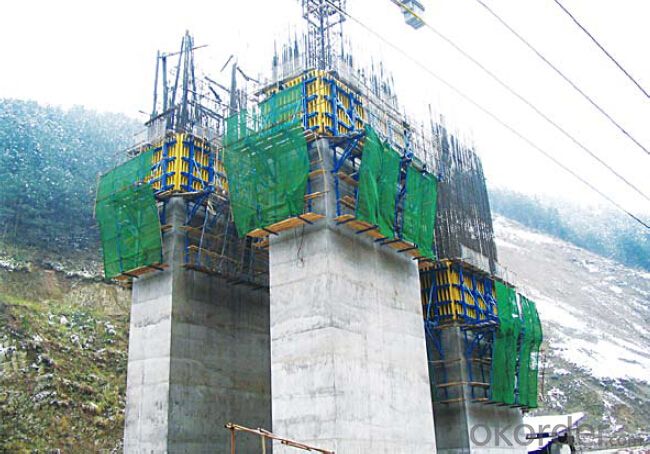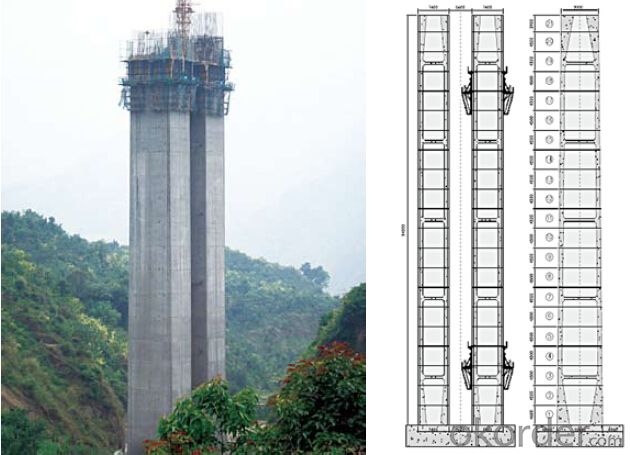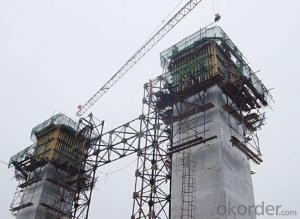Climbing-bracket CB-240 for formwork and scaffolding system
- Loading Port:
- Tianjin
- Payment Terms:
- TT OR LC
- Min Order Qty:
- 50 m²
- Supply Capability:
- 1000 m²/month
OKorder Service Pledge
OKorder Financial Service
You Might Also Like
Climbing Bracket CB240 & CB210
They are framework brackets for supporting large-area wall formwork.
Typical applications for the CB240&CB210 are pier and column/shear wall/core walll/ in the
building.
CB210 has smaller size than CB240, it will be cost effective in some condition.
Characteristics:
◆ High bearing capacity
The high loading capacity of the brackets allow very large scaffold units. This saves the number
anchor points required as well as reducing climbing times.
◆ Simple moving procedure by crane
Through the strong connection of formwork together with the climbing scaffold, both can be moved
as a single climbing unit by crane. Thus valuable time-savings can be achieved.
◆ Fast striking process without a crane
With the retrusive set, large formwork elements can also be retracted quickly and a minimum of
effort.
◆ Safe with work platform
The platforms have assembled firmly with bracket and will be climbing together, without scaffolding
but can work safely in spite of your high location.
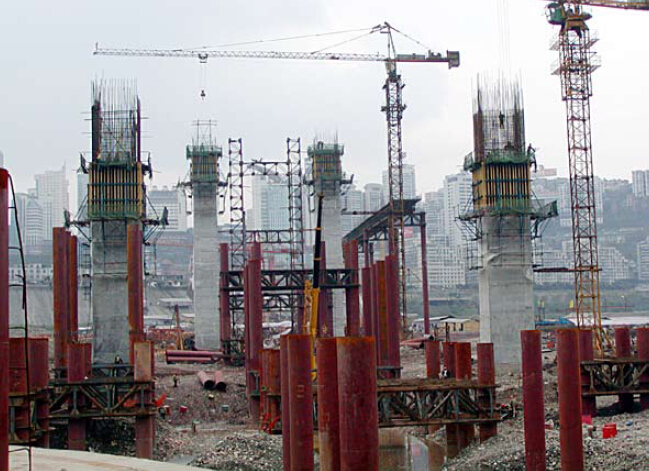
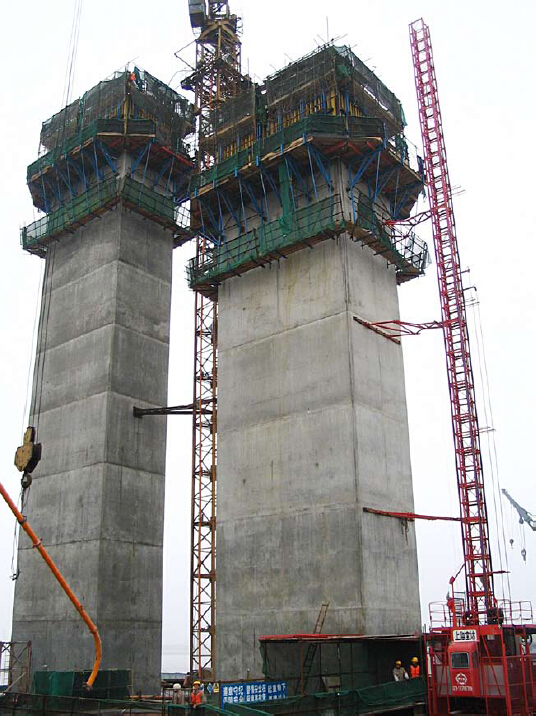
- Q: How does steel formwork affect the quality of concrete?
- Steel formwork can greatly affect the quality of concrete by providing a stable and precise mold for the concrete to be poured into. The use of steel formwork helps ensure uniformity in shape, size, and surface finish of the concrete, resulting in a higher quality and more consistent end product. The strength and durability of steel formwork also enable it to withstand the pressure exerted by the wet concrete, preventing any deformation or leakage that could compromise the integrity of the concrete structure.
- Q: Can steel formwork be used for curved or complex structures?
- Yes, steel formwork can be used for curved or complex structures. Steel formwork is highly versatile and can be easily shaped and adjusted to create various curved or complex shapes. Its strength and durability make it suitable for withstanding the pressure and forces exerted during the construction process of such structures.
- Q: Can steel formwork be used for structures with high chemical resistance requirements?
- No, steel formwork is not suitable for structures with high chemical resistance requirements. Steel is prone to corrosion and is not resistant to many harsh chemicals. When exposed to chemicals, steel formwork can deteriorate and lose its structural integrity, compromising the stability and safety of the structure. In such cases, alternative materials like chemically resistant plastics or composites should be considered to ensure the longevity and durability of the structure in environments with high chemical exposure.
- Q: How does steel formwork contribute to the overall efficiency of a construction project?
- There are several ways in which steel formwork enhances the efficiency of a construction project. Firstly, it is highly durable and can withstand the pressures and forces exerted during the concrete pouring process. This durability means that the formwork can be used repeatedly, reducing the need for frequent replacements and saving both time and costs. Furthermore, steel formwork is known for its flexibility and adaptability. It can be easily designed and fabricated to fit any desired shape or size, allowing for the construction of complex structures. This versatility eliminates the need for custom-made formwork, which can be time-consuming and expensive. Another advantage of steel formwork is its quick assembly and disassembly process. It is designed to be easily put together and taken apart, enabling faster construction cycles. This time-saving feature is particularly useful in projects with tight deadlines or situations where construction needs to progress rapidly. Moreover, steel formwork provides a smooth and consistent surface finish to the concrete. This is crucial for achieving high-quality results in architectural concrete applications, such as exposed concrete walls or decorative elements. The smooth finish reduces the need for additional surface treatments, saving time and costs during the finishing phase of the project. Additionally, steel formwork allows for better control over the concrete pouring process. Its rigidity and stability minimize the risk of concrete leakage or deformation, ensuring accurate and precise concrete placement. This level of control not only improves the overall quality of the construction but also reduces the likelihood of rework, saving time and resources. Lastly, steel formwork is highly resistant to environmental conditions, such as moisture and extreme temperatures. This durability ensures that the formwork remains intact and functional, even in challenging construction environments. Consequently, construction projects using steel formwork are less likely to experience delays or disruptions due to formwork failures or replacements. To sum up, steel formwork greatly enhances the overall efficiency of a construction project by providing durability, flexibility, quick assembly and disassembly, a smooth surface finish, control over the concrete pouring process, and resistance to environmental conditions. These advantages lead to time and cost savings, improved construction quality, and enhanced project timelines.
- Q: What are the different steel grades used in steel formwork?
- There are several different steel grades that are commonly used in steel formwork, each with their own specific characteristics and advantages. Some of the most common steel grades used in steel formwork include: 1. Mild Steel (Grade 250): Mild steel is a low carbon steel that is relatively inexpensive and easy to work with. It offers good strength and durability, making it suitable for many construction applications. However, it may not have the same level of resistance to corrosion as other steel grades. 2. High Tensile Steel (Grade 500): High tensile steel is a type of steel that has a higher strength-to-weight ratio compared to mild steel. It offers superior strength and durability, making it suitable for heavy-duty applications. High tensile steel is often used in formwork for structures that require greater load-bearing capacity. 3. Stainless Steel: Stainless steel is a corrosion-resistant alloy that contains a minimum of 10.5% chromium. It offers excellent resistance to corrosion, making it ideal for formwork that will be exposed to harsh environmental conditions or chemicals. Stainless steel also has a high strength-to-weight ratio and is often used in marine and chemical industry applications. 4. Weathering Steel (Grade 350): Weathering steel, also known as corten steel, is a high-strength, low-alloy steel that forms a protective layer of rust when exposed to the elements. This protective layer helps to prevent further corrosion, making it suitable for formwork in outdoor environments. Weathering steel is often used in bridge construction and other infrastructure projects. 5. Galvanized Steel: Galvanized steel is steel that has been coated with zinc to provide protection against corrosion. The zinc coating acts as a barrier, preventing moisture and oxygen from reaching the underlying steel. Galvanized steel formwork is commonly used in concrete construction, as it offers excellent corrosion resistance and durability. Overall, the choice of steel grade for steel formwork will depend on various factors including the specific application, load-bearing requirements, and environmental conditions. It is important to select the appropriate steel grade to ensure the longevity and performance of the formwork system.
- Q: What are the different types of edge protection used with steel formwork?
- There are several types of edge protection used with steel formwork to ensure safety and prevent accidents on construction sites. Some of the common types include: 1. Edge protection barriers: These are typically made of a sturdy material like steel or aluminum and are installed along the edges of the formwork. They act as a physical barrier to prevent workers from accidentally falling off the edge. Edge protection barriers are often adjustable and can be easily installed and removed as needed. 2. Toe boards: Toe boards are typically made of wood or steel and are installed along the lower edge of the formwork. They provide a barrier to prevent tools, equipment, or debris from falling off the edge. Toe boards also serve as a visual indicator, reminding workers to be cautious near the edge. 3. Handrails: Handrails are horizontal bars that are attached to vertical posts and are installed along the edges of the formwork. They provide a secure handhold for workers, helping them maintain balance and stability, especially when working at heights. Handrails are often required by safety regulations in certain situations. 4. Safety nets: Safety nets are installed below the formwork to catch any falling objects or debris. They are typically made of high-strength mesh material and are designed to absorb the impact of a falling object. Safety nets are useful when there is a risk of objects falling off the edge, such as during concrete pouring or during the removal of formwork. 5. Harnesses and lifelines: In certain high-risk situations, workers may be required to wear harnesses and use lifelines to protect themselves from falling. These systems consist of a harness that is worn by the worker and connected to a lifeline, which is securely anchored to a structure. Harnesses and lifelines provide an additional layer of protection in situations where edge protection alone may not be sufficient. It is important to note that the choice of edge protection will depend on the specific requirements of the project, local regulations, and the level of risk associated with the work being performed. It is crucial for construction companies to assess the site conditions and implement appropriate edge protection measures to ensure the safety of workers.
- Q: What are the different cost considerations associated with steel formwork?
- Some of the cost considerations associated with steel formwork include the initial purchase or rental cost of the formwork system, transportation and handling costs, installation and dismantling costs, maintenance and repair costs, and the potential for reusability and long-term cost savings compared to other formwork materials.
- Q: How does steel formwork affect the overall architectural aesthetics of the structure?
- The overall architectural aesthetics of a structure can be significantly impacted by steel formwork. When steel is used as a material for formwork, it can give the building a sleek and modern appearance. Its smooth and rigid surface allows for precise and clean lines, resulting in a more refined and elegant look. Steel formwork also provides great flexibility in terms of design possibilities. It can be easily shaped and molded into complex and intricate patterns, allowing architects to create unique and visually appealing structures. This versatility opens up a wide range of architectural possibilities and enables the creation of buildings with distinct and eye-catching features. Furthermore, steel formwork offers a high level of structural stability, which enhances the overall aesthetics of the structure. The use of steel ensures that the formwork remains strong and sturdy, even under heavy loads. This is crucial for creating large and imposing architectural designs. The ability to use steel formwork in such constructions allows architects to achieve bold and impressive architectural forms that might not be possible with other materials. In addition to its visual impact, steel formwork also offers practical advantages. It is a durable and long-lasting material that can withstand harsh weather conditions, making it suitable for both indoor and outdoor applications. Steel formwork is also highly resistant to fire, corrosion, and pests, further ensuring the longevity and integrity of the structure. Overall, steel formwork plays a crucial role in shaping the architectural aesthetics of a structure. Its smooth surface, flexibility in design, structural stability, and durability contribute to creating visually appealing and iconic buildings. By choosing steel formwork, architects can achieve both functional and aesthetic goals, resulting in structures that are not only beautiful but also reliable and long-lasting.
- Q: What are the different types of formwork anchors used in steel formwork?
- There are several types of formwork anchors that are commonly used in steel formwork. These anchors are essential for securing the formwork to the structure and ensuring the stability and safety of the construction process. Some of the different types of formwork anchors used in steel formwork include: 1. Wedge Anchor: This type of anchor consists of a threaded rod with a wedge-shaped end. It is inserted into a pre-drilled hole in the concrete structure and secured by tightening a nut on the threaded end. The wedge anchor provides a strong grip and is commonly used for securing formwork to concrete walls or slabs. 2. Screw Anchor: Screw anchors, also known as self-tapping anchors, are designed for use in softer materials such as wood or light-gauge steel. They have a threaded body that is screwed into the material, providing a secure connection for the formwork. Screw anchors are easy to install and remove, making them a popular choice for temporary formwork applications. 3. Hook Anchor: This type of anchor is shaped like a hook and is typically embedded into the concrete structure during the pouring process. The formwork is then attached to the hook using bolts or other fasteners. Hook anchors provide a strong and reliable connection and are commonly used in applications where high loads or lateral forces are expected. 4. Swift Lift Anchor: Swift lift anchors are specifically designed for lifting and handling precast concrete elements, including steel formwork. These anchors are embedded into the structure during the pouring process and provide a safe and efficient method for lifting and positioning the formwork. 5. Plate Anchor: Plate anchors consist of a flat plate with holes for bolts or other fasteners. They are commonly used in steel formwork systems to secure the formwork to the structure. Plate anchors are versatile and can be easily adjusted or relocated as needed. 6. Chemical Anchor: Chemical anchors are used when a strong and permanent connection is required. These anchors consist of a resin or adhesive that is injected into a pre-drilled hole in the concrete structure. The steel formwork is then attached to the chemical anchor, creating a secure bond. Each type of formwork anchor has its own unique advantages and is suitable for different applications. The choice of anchor will depend on factors such as the type of structure, the load requirements, and the duration of use. It is important to select the appropriate anchor and ensure proper installation to ensure the safety and stability of the formwork system.
- Q: How does steel formwork handle different concrete surface sealing products?
- Steel formwork is a widely used material in the construction industry for creating molds or structures to pour concrete into. When it comes to dealing with different sealing products for concrete surfaces, steel formwork offers certain advantages and considerations. First and foremost, steel formwork is exceptionally durable and strong, making it ideal for withstanding the application of various sealing products for concrete surfaces. These sealing products, like epoxy coatings, polyurethane sealers, or acrylic sealants, are typically designed to improve the durability, appearance, and resistance of the concrete surface. Steel formwork can handle the application process without sustaining any damage or compromise. Additionally, steel formwork provides a smooth and uniform surface for applying sealing products to concrete surfaces. This is crucial because a proper seal requires an even and consistent application to ensure optimal performance. With proper construction and maintenance, steel formwork can provide the necessary precision and flatness required for successful sealing product application. However, it is important to note that using specific sealing products for concrete surfaces may necessitate additional preparation and precautions when utilizing steel formwork. For example, if a sealing product requires a clean and porous surface to adhere properly, the steel formwork may need treatment or roughening to create the desired surface texture. Techniques like sandblasting or the application of a bonding agent can achieve this. Furthermore, before applying sealing products to concrete surfaces, it is crucial to ensure that the steel formwork is thoroughly cleaned and free from any residues or contaminants. Any remaining concrete, oils, or dirt on the formwork may interfere with the adhesion and performance of the sealing products. Regular maintenance and cleaning of the steel formwork are essential to guarantee its compatibility with various sealing products for concrete surfaces. In conclusion, steel formwork is a dependable and robust material that can handle different sealing products for concrete surfaces. Its durability, precision, and smooth surface make it a suitable choice for applying various sealing products. However, optimal compatibility and performance may require additional preparation, maintenance, and cleaning.
Send your message to us
Climbing-bracket CB-240 for formwork and scaffolding system
- Loading Port:
- Tianjin
- Payment Terms:
- TT OR LC
- Min Order Qty:
- 50 m²
- Supply Capability:
- 1000 m²/month
OKorder Service Pledge
OKorder Financial Service
Similar products
Hot products
Hot Searches


